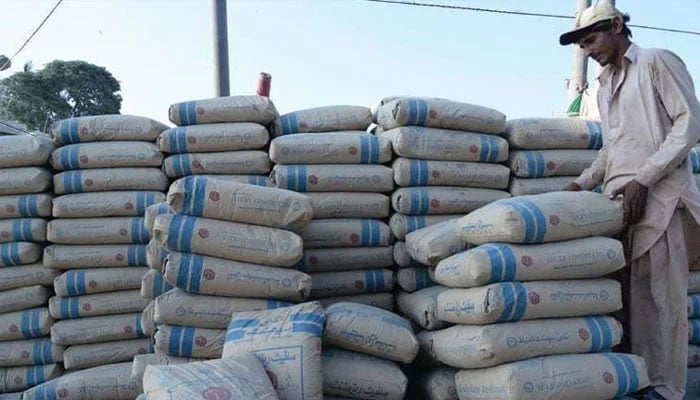Our Terms & Conditions | Our Privacy Policy
Cementing a green future

A labour stands alongside a heap of stacked-up cement bags somewhere in Pakistan. — AFP/File
The cement industry in Pakistan is at a critical juncture. As one of the major contributors to the national economy, the sector faces mounting challenges, rising coal prices, increasing environmental regulations and global pressure to reduce carbon emissions.
To maintain its competitiveness and ensure long-term viability, the industry must embrace energy-efficient production methods. The reliance on coal, especially imported African and Afghan coal, presents financial risks that could be mitigated by adopting more energy-efficient technologies.
By optimising energy consumption, cement manufacturers can reduce costs, lower carbon emissions and align with sustainability goals – all while ensuring compliance with emerging international trade regulations.
Coal remains the primary energy source for cement production in Pakistan, with prices varying significantly. African coal is priced at $198 per ton, Afghan coal at $162 per ton, and domestic Pakistani coal is the most affordable at approximately $93 per ton. Given this heavy dependence on coal, optimising energy consumption per ton of clinker is crucial for reducing costs and mitigating price volatility.
The International Energy Agency (IEA) estimates that to reach net-zero carbon emissions by 2050, clinker production must reduce its energy intensity by 0.8 per cent annually, reaching a global average of 3.2 gigajoules (GJ) per ton of clinker. This transition can be facilitated by integrating biomass and renewable waste into the energy mix. Cement production requires 3.6 to 4.0 GJ per ton of clinker, making fuel costs a significant part of production expenses.
At present energy consumption levels, the cost per ton of clinker is $31.70 using African coal, $25.94 with Afghan coal, and $14.99 with Pakistani coal. By reducing energy consumption to 3.2 GJ per ton by 2050, these costs could decrease to $25.36, $20.75, and $11.99 per ton, respectively, offering substantial savings across the industry.
Implementing an annual energy intensity reduction of 0.8 per cent to 1.0 per cent would help Pakistan’s cement industry lower costs considerably over the next 25 years. Such a shift would allow manufacturers to hedge against unpredictable fuel price fluctuations while keeping production costs competitive.
Even in the short term, a modest reduction in energy intensity can yield noticeable savings. For example, by 2026, energy consumption per ton of clinker could drop from 4.0 GJ to 3.97 GJ, and by 2030, it could reach 3.84 GJ. As companies transition to more energy-efficient processes, these savings will compound, improving both operational profitability and long-term financial stability.
On a national scale, the cost advantages of energy efficiency become even more apparent. The cement industry in Pakistan currently spends approximately $224,336 per day on African coal-based energy, $183,547 on Afghan coal, and $106,049 on Pakistani coal. By implementing energy efficiency measures, these figures could drop to $179,468, $146,838, and $84,839, respectively, offering savings of $44,867 per day for African coal, $36,709 for Afghan coal, and $21,209 for Pakistani coal.
These savings could be reinvested in further decarbonisation efforts, infrastructure upgrades, and industry expansion. A more energy-efficient cement industry would be better positioned to withstand economic uncertainties while fostering innovation and sustainability.
Cement production is a major contributor to greenhouse gas emissions due to the energy-intensive process of clinker manufacturing. The industry currently emits 0.39 tons of carbon dioxide per ton of clinker, resulting in daily national emissions of 2,740 tons. Targeted energy efficiency improvements could reduce emissions to 0.31 tons per ton of clinker, cutting daily emissions by 548 tons. This reduction not only supports Pakistan’s climate commitments but also enhances the sector’s ability to attract green financing and participate in global carbon credit markets. Companies that proactively decarbonise will gain a competitive advantage as sustainability becomes increasingly important in global business practices.
As global trade regulations evolve, Pakistan’s cement industry must anticipate carbon-related tariffs such as the European Union’s Carbon Border Adjustment Mechanism (CBAM), which imposes additional costs on imports based on their carbon emissions. While CBAM does not yet apply to Pakistan’s cement sector, as the country does not export cement to the EU, similar regulations could be adopted by other nations in the future.
If Pakistan’s cement industry seeks to expand into European markets, adopting energy-efficient technologies and emissions reduction strategies early will be critical. Energy efficiency, therefore, becomes not just a cost-saving measure but a necessary strategy for market entry. Implementing energy-efficient technologies now will help meet global sustainability standards and ensure that Pakistan’s cement manufacturers remain viable in an increasingly carbon-conscious global market. Without improvements in emissions intensity, Pakistan’s cement exports could become less competitive due to higher carbon-related costs imposed by CBAM and similar regulations in other regions.
Achieving energy efficiency in cement production requires sustained investment, innovation, and collaboration. Key strategies include adopting alternative fuels such as biomass and renewable energy, upgrading technologies like waste heat recovery systems and modern kilns, and using calcined clays to reduce energy use and carbon dioxide emissions.
Carbon dioxide sequestration technologies and carbon-infused concrete can further reduce emissions, while government incentives and green policies can accelerate this transition. As climate change poses significant risks, energy efficiency is not just an environmental obligation; it is a financial necessity. By embracing these energy-efficient practices, Pakistan’s cement sector can become a regional leader in sustainability, ensuring its long-term economic viability and resilience in the face of both climate change and market pressures.
The writer is a sustainability consultant and a research associate at the Sustainable
Development Policy Institute (SDPI), Islamabad.
[ad_1]
Images are for reference only.Images and contents gathered automatic from google or 3rd party sources.All rights on the images and contents are with their legal original owners.
[ad_2]


Comments are closed.